Unit 2 I'll help clean up the city park Section A(4a-4c)课件(共40张PPT)人教版八年级下册
文档属性
| 名称 | Unit 2 I'll help clean up the city park Section A(4a-4c)课件(共40张PPT)人教版八年级下册 | 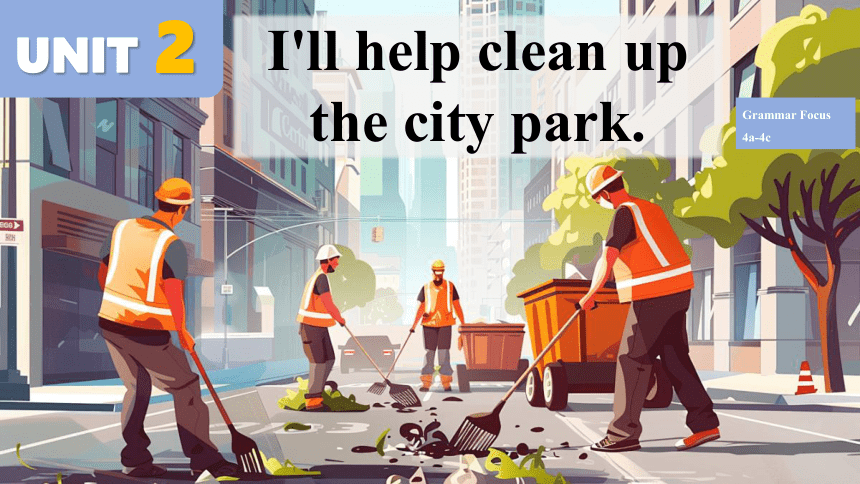 | |
| 格式 | pptx | ||
| 文件大小 | 5.2MB | ||
| 资源类型 | 教案 | ||
| 版本资源 | 人教新目标(Go for it)版 | ||
| 科目 | 英语 | ||
| 更新时间 | 2025-05-31 13:44:38 | ||
图片预览

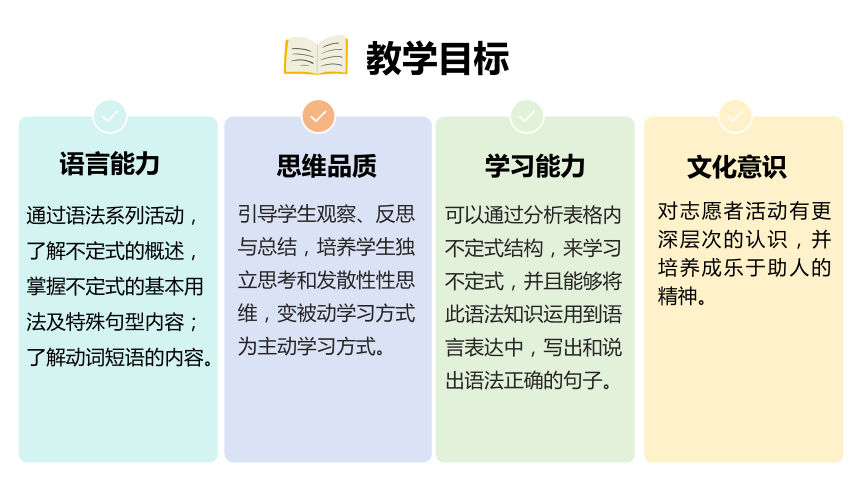






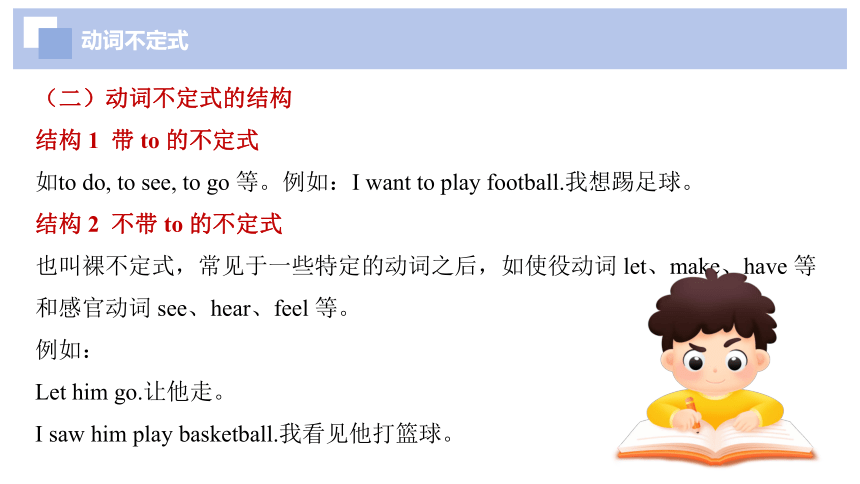

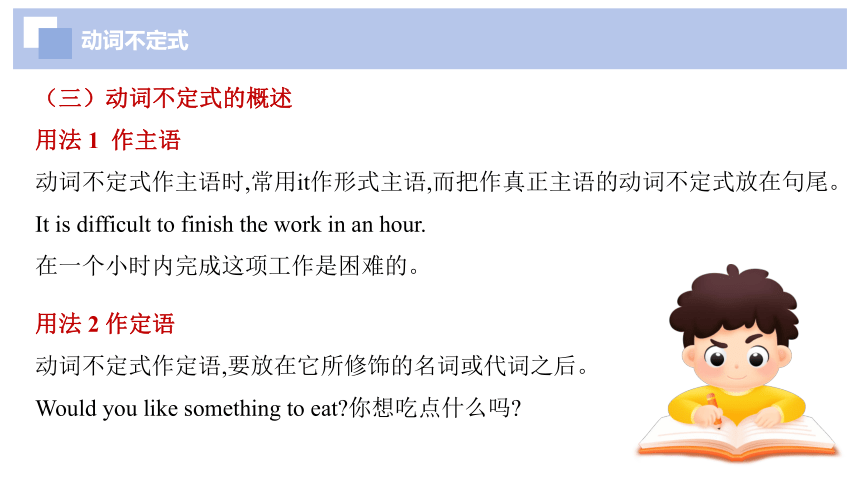
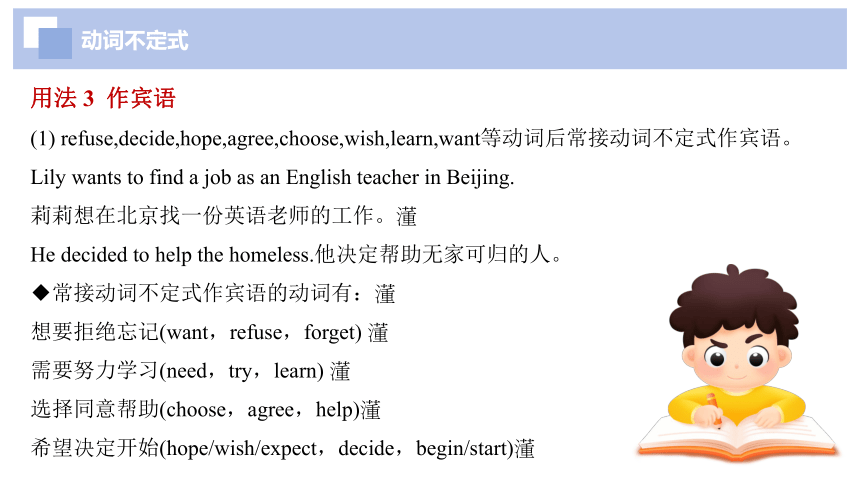
文档简介
(共40张PPT)
UNIT 2
I'll help clean up the city park.
Grammar Focus 4a-4c
思维品质
学习能力
文化意识
语言能力
教学目标
通过语法系列活动,了解不定式的概述,掌握不定式的基本用法及特殊句型内容;了解动词短语的内容。
可以通过分析表格内不定式结构,来学习不定式,并且能够将此语法知识运用到语言表达中,写出和说出语法正确的句子。
对志愿者活动有更深层次的认识,并培养成乐于助人的精神。
引导学生观察、反思与总结,培养学生独立思考和发散性性思维,变被动学习方式为主动学习方式。
能够通过语法表格,了解并掌握不定式的内容;
能够通过选词填空,了解并掌握动词短语的内容。
如何使用不定式与动词短语帮助他人的内容,同时传递自己及他人想法;
如何鼓励学生在日常生活中培养帮助他人的品格。
01
02
教学重难点
01
Grammar
Focus
SECTION A
Lead-in
1
This weekend, what do Mario and Mary expect to do Let’s read the passage to find out the answers.
While you are reading, underline the infinitives(不定式).
Lead-in
1
This weekend, Mario and Mary plan to help others.
Mario wants to learn more about how to care for dogs, so he expects to learn from the experienced vets. He hopes to find one, but all vets are too busy.
Mary wants to help the left-behind children to read, so she’d like to send some books to them from the school library. Luckily, the librarian agrees to do that.
Presentation
2
Tip: 观察 思考 总结 回答
1. 请翻译下列句子
2. 找到不定式
4. 不定式都有什么结构呢?
5.不定式都有什么样的作用呢?
3.不定式是什么?
Listen and fill in the blanks.
动词不定式
(一)动词不定式的概述
动词不定式的基本形式是“to+动词原形”,有时to可以省略。否定形式为not to do。动词不定式在句中可以作主语、宾语、表语、定语和状语,还可用在复合结构中。例如:
She hopes to get a good grade in the exam.她希望在考试中取得好成绩。
The best way to solve this problem is to ask the teacher.解决这个问题的最好方法是问老师。
We heard her sing a beautiful song last night.昨晚我们听到她唱了一首动听的歌。
Listen and fill in the blanks.
动词不定式
(二)动词不定式的结构
结构 1 带 to 的不定式
如to do, to see, to go 等。例如:I want to play football.我想踢足球。
结构 2 不带 to 的不定式
也叫裸不定式,常见于一些特定的动词之后,如使役动词 let、make、have 等和感官动词 see、hear、feel 等。
例如:
Let him go.让他走。
I saw him play basketball.我看见他打篮球。
Listen and fill in the blanks.
动词不定式
结构 3 动词不定式/原形的否定式
否定式是直接在 “to” 前面加 “not” ,构成 “not to + 动词原形”;若为不带 “to” 的不定式,直接在动词原形前加 “not”。
例如:
正常形式:To make such mistakes is careless.犯这样的错误很粗心。
否定形式:Not to make such mistakes is what he wishes.
不犯这样的错误是他所希望的。
正常形式:I have some books to read.我有一些书要读。
否定形式:He has no chance not to pass the exam.他不可能考试不及格。
Listen and fill in the blanks.
动词不定式
(三)动词不定式的概述
用法 1 作主语
动词不定式作主语时,常用it作形式主语,而把作真正主语的动词不定式放在句尾。It is difficult to finish the work in an hour.
在一个小时内完成这项工作是困难的。
用法 2 作定语
动词不定式作定语,要放在它所修饰的名词或代词之后。
Would you like something to eat 你想吃点什么吗
Listen and fill in the blanks.
动词不定式
用法 3 作宾语
(1) refuse,decide,hope,agree,choose,wish,learn,want等动词后常接动词不定式作宾语。
Lily wants to find a job as an English teacher in Beijing.
莉莉想在北京找一份英语老师的工作。
He decided to help the homeless.他决定帮助无家可归的人。
◆常接动词不定式作宾语的动词有:
想要拒绝忘记(want,refuse,forget)
需要努力学习(need,try,learn)
选择同意帮助(choose,agree,help)
希望决定开始(hope/wish/expect,decide,begin/start)
Listen and fill in the blanks.
动词不定式
用法 3 作宾语
(2) 动词不定式可以和what,which,how,where,when等连用,构成“特殊疑问词+动词不定式”结构,可在句中作主语、宾语、宾语补足语等。
How to get there is a problem.如何到达那里是一个问题。 (作主语)
I don’t know what to say.我不知道说什么。(作宾语)
He taught himself how to use the computer.
他自学了如何使用电脑。(作宾语补足语)
Listen and fill in the blanks.
动词不定式
用法 4 作宾语补足语
动词不定式作宾语补足语,也是在一些特定的动词之后,常见的接动词不定式作宾语补足语的动词有:
(1)ask/like/tell/want/...+sb.+to do sth.
(2)let/have/make/feel/hear/see/watch/...+sb.+do sth.(此处省略了to)
(3)help sb.(to) do sth.(动词不定式to可带,也可省略)
例如:
She wants her daughter to learn the piano.她想让她女儿学钢琴。
Listen and fill in the blanks.
动词不定式
用法 5 作表语
动词不定式作表语时,通常位于系动词(如 be、seem、appear 等)之后,对主语进行补充说明,表明主语的具体内容、性质、目的或将来的动作等。
例如:
The most important thing is to protect the environment.最重要的事情是保护环境。
Our plan is to visit the museum next week.我们的计划是下周去参观博物馆。
What he wants to do is to travel around the world.他想做的事是环游世界。
All I did was (to) wait for him.我所做的一切就是等他。
Her task today is to teach the new lesson.她今天的任务是教新课。
Listen and fill in the blanks.
动词不定式
用法 6 作状语
(1) 作目的状语
强调动词不定式所表示的目的时,动词不定式可用in order to或so as to +动词原形,so as to不用于句首。
The bus stopped so as to pick up passengers.这辆公交车停下来接乘客。
(2) 作结果状语
The boy is old enough to look after himself.这个男孩足够大,可以照顾他自己了。
Listen and fill in the blanks.
动词不定式
用法 7 特殊句型
(1) “too...to...” 句型
结构:“too + 形容词 / 副词 + to + 动词原形”,表示 “太…… 而不能……”。
该句型中,“too” 后面接描述事物特征的形容词或副词,“to” 后面接动词原形,表示因为前面描述的程度而导致不能进行后面的动作。
例句
He is too young to go to school.(他太小了,不能去上学。)
The problem is too difficult to solve.(这个问题太难了,无法解决。)
Listen and fill in the blanks.
动词不定式
【特殊情况】
当 “too” 后面的形容词是 “ready(乐意的)”、“eager(渴望的)”、“anxious(急切的)”、“willing(愿意的)” 等词时,“too...to...” 结构不再表示否定意义,而是表示肯定意义,意为 “非常…… 以至于……”。
例如:He is too ready to help others.(他非常乐意帮助别人。)
Listen and fill in the blanks.
动词不定式
(2) “enough...to...” 句型
结构:“形容词 / 副词 + enough + to + 动词原形” 或者 “名词 + enough + to + 动词原形”,表示 “足够…… 可以做……”。
“enough” 作为副词修饰形容词或副词时,要放在所修饰词的后面;作为形容词修饰名词时,可前可后。
例句
He is old enough to take care of himself.(他足够大了,可以照顾自己了。)
We have enough time to finish the work.(我们有足够的时间完成这项工作。)
Listen and fill in the blanks.
动词不定式
(3) “so...as to...” 句型
结构:“so + 形容词 / 副词 + as to + 动词原形”,表示 “如此…… 以至于……”,通常用来描述程度和结果的关系。
此句型强调因为前面的状态达到了某种程度,从而导致了后面的结果。
例句
He ran so fast as to catch the first bus.他跑得如此快以至于赶上了第一班公交车。
She was so angry as to throw the book on the floor.她如此生气以至于把书扔到了地上。
Listen and fill in the blanks.
动词不定式
(4) “Why not... ” 句型
结构:“Why not + 动词原形”,相当于 “Why don't you + 动词原形”,用来提出建议或劝告,意为 “为什么不…… 呢?”
用法说明
这是一种比较口语化且常用的提建议方式,后面直接跟动词原形。
例句
Why not go for a walk after dinner (晚饭后为什么不去散散步呢?)
Why not try again (为什么不再试一次呢?)
Listen and fill in the blanks.
动词不定式
(5) “It takes/took sb. some time to do sth.” 句型
结构:“It takes/took + 某人 + 一段时间 + to + 动词原形 + 其他”,表示 “做某事花费某人多长时间”。
“It” 是形式主语,真正的主语是后面的动词不定式短语 “to do sth.”。“takes” 用于一般现在时,“took” 用于一般过去时。
例句
It takes me half an hour to go to school by bike every day.
我每天骑自行车上学要花半个小时。
Listen and fill in the blanks.
动词不定式
(6) “There be + 名词 + to do” 句型
结构:“There be + 名词 + to + 动词原形”,表示 “有…… 要做”。
用法说明
此句型中,动词不定式作后置定语,修饰前面的名词。
例句
There is a lot of work to do.(有很多工作要做。)
There are many books to read.(有很多书要读。)
Practice
3
1. I want to ____________ my plan to work in an animal hospital until next summer. I’m too busy with my studies this year.
2. She hopes to ____________ at least five primary schools to ask if they need volunteers for their after-school programs.
3. Our class is trying to ____________ some ideas to ____________ sick children because they are often sad.
4. We decided to ____________ signs around the school and ____________ notices to tell students about the book sale. We will ____________ the money from the sale to homeless people.
4a Fill in the blanks with the phrasal verbs in the box.
put up
hand out
call up
cheer up
come up with
give out
put off
put off
call up
come up with
cheer up
put up
hand out
give out
Listen and fill in the blanks.
动词短语
短语动词是由动词加介词、副词或其他词构成的固定词组或习语(idioms),其作用和动词差不多。有些短语动词相当于及物动词,有些则相当于不及物动词。
1.动词+介词
相当于及物动词,后面必须有宾语,且宾语只能位于介词之后。
例如:
speak/talk about 谈论。
We are talking about the movie.我们正在谈论那部电影。
belong to 属于。This book belongs to me.这本书属于我。
Listen and fill in the blanks.
动词短语
2.动词+副词
看作及物动词,名词作宾语时,可位于动词与副词之间或副词之后;代词作宾语时;只能位于动词与副词之间。
give away 赠送,分发;泄露。
She gave away all her old clothes.
她把所有的旧衣服都送出去了。
show around 带领…… 参观。
The guide showed us around the museum.
导游带我们参观了博物馆。
Listen and fill in the blanks.
动词短语
3.动词+副词+介词
相当于及物动词,宾语位于介词之后。
come up with
含义:想出;提出(主意、计划等)
例句:Can you come up with a better solution to this problem
你能想出一个更好的解决这个问题的办法吗?
get on with
含义:与…… 相处;继续做
例句:Get on with your homework! 继续做你的家庭作业!
Listen and fill in the blanks.
动词短语
4.动词+名词+介词
相当于及物动词,名词前可加形容词说明程度,宾语位于介词之后。
pay attention to 注意;重视
例句:Please pay attention to your spelling when you write.
你写作时要注意拼写。
take care of 照顾;照料
例句:She stayed at home to take care of her sick mother.
她待在家里照顾生病的母亲。
Listen and fill in the blanks.
动词短语
5.be+形容词+介词
相当于及物动词, 宾语位于介词之后。
be famous for 因…… 而著名
例句:France is famous for its wine and fashion.
法国以其葡萄酒和时尚而闻名。
be angry with 对…… 生气
例句:The teacher is angry with the naughty boy.
老师对这个淘气的男孩很生气。
Practice
3
Most people today are only worried about getting good jobs 1. _______ lots of money.
In their free time, they think about what 2. _______ for fun. However, few people think about what they can do 3. _______ others. There are many people who are less lucky than us. Volunteering our time to help these people is a good way 4. _______ our free time. For example, we can make plans 5. _______ sick children in the hospital or raise money for homeless people. Some people even stop doing their jobs for a few months to a year
6. _______ to another place, like one of the countries in Africa, and help people there.
4b Fill in the blanks with the correct forms of the verbs in the box.
help move do make visit spend
to make
to do
to help
to spend
to visit
to move
4c Complete the sentences with your own ideas. Use infinitives.
1. I’d like to volunteer ______________________________________________________
2. At 12: a.m., I called my friend______________________________________________
3. I’m very busy but I could help______________________________________________
4. Summer vacation is coming, and I want ______________________________________
5. I want to travel alone. My parents told me (not) ________________________________
Production
4
to help kids with their homework.
to play soccer together in the afternoon.
take the trash out after dinner.
not to do that.
to go camping with my friends.
4c Complete the sentences with your own ideas. Use infinitives.
1. I’d like to volunteer ______________________________________________________
2. At 12: a.m., I called my friend______________________________________________
3. I’m very busy but I could help______________________________________________
4. Summer vacation is coming, and I want ______________________________________
5. I want to travel alone. My parents told me (not) ________________________________
Production
4
to help kids with their homework.
to play soccer together in the afternoon.
take the trash out after dinner.
not to do that.
to go camping with my friends.
There is no exercise better for the heart than reaching down and lifting people up!
1. —Julia, your mobile phone is ringing.
—Wait a minute. It’s dangerous _____ it while crossing the
street.
A. answering B. answer C. to answer
2. — I will go to Harbin for my summer vacation. What about you
— I haven’t decided where ____.
A. go B. went C. going D. to go
3.I always tell my students ____ on the road because it’s really dangerous.
A. not to play B. to play not C. not playing D. not play
Exercise-单项选择
√
√
√
1. The students are ______ leaflets(传单)to the people in the street to ask them to protect the environment.
A. putting up B. handing out C. calling up D. coming up with
2. We have to ______ the sports meeting because of the bad weather.
A. put off B. put up C. give out D. cheer up
3. I tried to ______ my friend when he was in a bad mood, but it didn't work.
A. call up B. come up withC. cheer up D. hand out
Exercise-单项选择
√
√
√
02
Summary
SECTION A
03
Homework
SECTION A
Homework
English skit:Work with your group members to write and perform an English skit. The content of the skit should use at least 10 different phrasal verbs, and each phrasal verb should be clearly demonstrated through the actors' actions, expressions, and lines.
SEE YOU NEXT CLASS!
UNIT 2
I'll help clean up the city park.
Grammar Focus 4a-4c
思维品质
学习能力
文化意识
语言能力
教学目标
通过语法系列活动,了解不定式的概述,掌握不定式的基本用法及特殊句型内容;了解动词短语的内容。
可以通过分析表格内不定式结构,来学习不定式,并且能够将此语法知识运用到语言表达中,写出和说出语法正确的句子。
对志愿者活动有更深层次的认识,并培养成乐于助人的精神。
引导学生观察、反思与总结,培养学生独立思考和发散性性思维,变被动学习方式为主动学习方式。
能够通过语法表格,了解并掌握不定式的内容;
能够通过选词填空,了解并掌握动词短语的内容。
如何使用不定式与动词短语帮助他人的内容,同时传递自己及他人想法;
如何鼓励学生在日常生活中培养帮助他人的品格。
01
02
教学重难点
01
Grammar
Focus
SECTION A
Lead-in
1
This weekend, what do Mario and Mary expect to do Let’s read the passage to find out the answers.
While you are reading, underline the infinitives(不定式).
Lead-in
1
This weekend, Mario and Mary plan to help others.
Mario wants to learn more about how to care for dogs, so he expects to learn from the experienced vets. He hopes to find one, but all vets are too busy.
Mary wants to help the left-behind children to read, so she’d like to send some books to them from the school library. Luckily, the librarian agrees to do that.
Presentation
2
Tip: 观察 思考 总结 回答
1. 请翻译下列句子
2. 找到不定式
4. 不定式都有什么结构呢?
5.不定式都有什么样的作用呢?
3.不定式是什么?
Listen and fill in the blanks.
动词不定式
(一)动词不定式的概述
动词不定式的基本形式是“to+动词原形”,有时to可以省略。否定形式为not to do。动词不定式在句中可以作主语、宾语、表语、定语和状语,还可用在复合结构中。例如:
She hopes to get a good grade in the exam.她希望在考试中取得好成绩。
The best way to solve this problem is to ask the teacher.解决这个问题的最好方法是问老师。
We heard her sing a beautiful song last night.昨晚我们听到她唱了一首动听的歌。
Listen and fill in the blanks.
动词不定式
(二)动词不定式的结构
结构 1 带 to 的不定式
如to do, to see, to go 等。例如:I want to play football.我想踢足球。
结构 2 不带 to 的不定式
也叫裸不定式,常见于一些特定的动词之后,如使役动词 let、make、have 等和感官动词 see、hear、feel 等。
例如:
Let him go.让他走。
I saw him play basketball.我看见他打篮球。
Listen and fill in the blanks.
动词不定式
结构 3 动词不定式/原形的否定式
否定式是直接在 “to” 前面加 “not” ,构成 “not to + 动词原形”;若为不带 “to” 的不定式,直接在动词原形前加 “not”。
例如:
正常形式:To make such mistakes is careless.犯这样的错误很粗心。
否定形式:Not to make such mistakes is what he wishes.
不犯这样的错误是他所希望的。
正常形式:I have some books to read.我有一些书要读。
否定形式:He has no chance not to pass the exam.他不可能考试不及格。
Listen and fill in the blanks.
动词不定式
(三)动词不定式的概述
用法 1 作主语
动词不定式作主语时,常用it作形式主语,而把作真正主语的动词不定式放在句尾。It is difficult to finish the work in an hour.
在一个小时内完成这项工作是困难的。
用法 2 作定语
动词不定式作定语,要放在它所修饰的名词或代词之后。
Would you like something to eat 你想吃点什么吗
Listen and fill in the blanks.
动词不定式
用法 3 作宾语
(1) refuse,decide,hope,agree,choose,wish,learn,want等动词后常接动词不定式作宾语。
Lily wants to find a job as an English teacher in Beijing.
莉莉想在北京找一份英语老师的工作。
He decided to help the homeless.他决定帮助无家可归的人。
◆常接动词不定式作宾语的动词有:
想要拒绝忘记(want,refuse,forget)
需要努力学习(need,try,learn)
选择同意帮助(choose,agree,help)
希望决定开始(hope/wish/expect,decide,begin/start)
Listen and fill in the blanks.
动词不定式
用法 3 作宾语
(2) 动词不定式可以和what,which,how,where,when等连用,构成“特殊疑问词+动词不定式”结构,可在句中作主语、宾语、宾语补足语等。
How to get there is a problem.如何到达那里是一个问题。 (作主语)
I don’t know what to say.我不知道说什么。(作宾语)
He taught himself how to use the computer.
他自学了如何使用电脑。(作宾语补足语)
Listen and fill in the blanks.
动词不定式
用法 4 作宾语补足语
动词不定式作宾语补足语,也是在一些特定的动词之后,常见的接动词不定式作宾语补足语的动词有:
(1)ask/like/tell/want/...+sb.+to do sth.
(2)let/have/make/feel/hear/see/watch/...+sb.+do sth.(此处省略了to)
(3)help sb.(to) do sth.(动词不定式to可带,也可省略)
例如:
She wants her daughter to learn the piano.她想让她女儿学钢琴。
Listen and fill in the blanks.
动词不定式
用法 5 作表语
动词不定式作表语时,通常位于系动词(如 be、seem、appear 等)之后,对主语进行补充说明,表明主语的具体内容、性质、目的或将来的动作等。
例如:
The most important thing is to protect the environment.最重要的事情是保护环境。
Our plan is to visit the museum next week.我们的计划是下周去参观博物馆。
What he wants to do is to travel around the world.他想做的事是环游世界。
All I did was (to) wait for him.我所做的一切就是等他。
Her task today is to teach the new lesson.她今天的任务是教新课。
Listen and fill in the blanks.
动词不定式
用法 6 作状语
(1) 作目的状语
强调动词不定式所表示的目的时,动词不定式可用in order to或so as to +动词原形,so as to不用于句首。
The bus stopped so as to pick up passengers.这辆公交车停下来接乘客。
(2) 作结果状语
The boy is old enough to look after himself.这个男孩足够大,可以照顾他自己了。
Listen and fill in the blanks.
动词不定式
用法 7 特殊句型
(1) “too...to...” 句型
结构:“too + 形容词 / 副词 + to + 动词原形”,表示 “太…… 而不能……”。
该句型中,“too” 后面接描述事物特征的形容词或副词,“to” 后面接动词原形,表示因为前面描述的程度而导致不能进行后面的动作。
例句
He is too young to go to school.(他太小了,不能去上学。)
The problem is too difficult to solve.(这个问题太难了,无法解决。)
Listen and fill in the blanks.
动词不定式
【特殊情况】
当 “too” 后面的形容词是 “ready(乐意的)”、“eager(渴望的)”、“anxious(急切的)”、“willing(愿意的)” 等词时,“too...to...” 结构不再表示否定意义,而是表示肯定意义,意为 “非常…… 以至于……”。
例如:He is too ready to help others.(他非常乐意帮助别人。)
Listen and fill in the blanks.
动词不定式
(2) “enough...to...” 句型
结构:“形容词 / 副词 + enough + to + 动词原形” 或者 “名词 + enough + to + 动词原形”,表示 “足够…… 可以做……”。
“enough” 作为副词修饰形容词或副词时,要放在所修饰词的后面;作为形容词修饰名词时,可前可后。
例句
He is old enough to take care of himself.(他足够大了,可以照顾自己了。)
We have enough time to finish the work.(我们有足够的时间完成这项工作。)
Listen and fill in the blanks.
动词不定式
(3) “so...as to...” 句型
结构:“so + 形容词 / 副词 + as to + 动词原形”,表示 “如此…… 以至于……”,通常用来描述程度和结果的关系。
此句型强调因为前面的状态达到了某种程度,从而导致了后面的结果。
例句
He ran so fast as to catch the first bus.他跑得如此快以至于赶上了第一班公交车。
She was so angry as to throw the book on the floor.她如此生气以至于把书扔到了地上。
Listen and fill in the blanks.
动词不定式
(4) “Why not... ” 句型
结构:“Why not + 动词原形”,相当于 “Why don't you + 动词原形”,用来提出建议或劝告,意为 “为什么不…… 呢?”
用法说明
这是一种比较口语化且常用的提建议方式,后面直接跟动词原形。
例句
Why not go for a walk after dinner (晚饭后为什么不去散散步呢?)
Why not try again (为什么不再试一次呢?)
Listen and fill in the blanks.
动词不定式
(5) “It takes/took sb. some time to do sth.” 句型
结构:“It takes/took + 某人 + 一段时间 + to + 动词原形 + 其他”,表示 “做某事花费某人多长时间”。
“It” 是形式主语,真正的主语是后面的动词不定式短语 “to do sth.”。“takes” 用于一般现在时,“took” 用于一般过去时。
例句
It takes me half an hour to go to school by bike every day.
我每天骑自行车上学要花半个小时。
Listen and fill in the blanks.
动词不定式
(6) “There be + 名词 + to do” 句型
结构:“There be + 名词 + to + 动词原形”,表示 “有…… 要做”。
用法说明
此句型中,动词不定式作后置定语,修饰前面的名词。
例句
There is a lot of work to do.(有很多工作要做。)
There are many books to read.(有很多书要读。)
Practice
3
1. I want to ____________ my plan to work in an animal hospital until next summer. I’m too busy with my studies this year.
2. She hopes to ____________ at least five primary schools to ask if they need volunteers for their after-school programs.
3. Our class is trying to ____________ some ideas to ____________ sick children because they are often sad.
4. We decided to ____________ signs around the school and ____________ notices to tell students about the book sale. We will ____________ the money from the sale to homeless people.
4a Fill in the blanks with the phrasal verbs in the box.
put up
hand out
call up
cheer up
come up with
give out
put off
put off
call up
come up with
cheer up
put up
hand out
give out
Listen and fill in the blanks.
动词短语
短语动词是由动词加介词、副词或其他词构成的固定词组或习语(idioms),其作用和动词差不多。有些短语动词相当于及物动词,有些则相当于不及物动词。
1.动词+介词
相当于及物动词,后面必须有宾语,且宾语只能位于介词之后。
例如:
speak/talk about 谈论。
We are talking about the movie.我们正在谈论那部电影。
belong to 属于。This book belongs to me.这本书属于我。
Listen and fill in the blanks.
动词短语
2.动词+副词
看作及物动词,名词作宾语时,可位于动词与副词之间或副词之后;代词作宾语时;只能位于动词与副词之间。
give away 赠送,分发;泄露。
She gave away all her old clothes.
她把所有的旧衣服都送出去了。
show around 带领…… 参观。
The guide showed us around the museum.
导游带我们参观了博物馆。
Listen and fill in the blanks.
动词短语
3.动词+副词+介词
相当于及物动词,宾语位于介词之后。
come up with
含义:想出;提出(主意、计划等)
例句:Can you come up with a better solution to this problem
你能想出一个更好的解决这个问题的办法吗?
get on with
含义:与…… 相处;继续做
例句:Get on with your homework! 继续做你的家庭作业!
Listen and fill in the blanks.
动词短语
4.动词+名词+介词
相当于及物动词,名词前可加形容词说明程度,宾语位于介词之后。
pay attention to 注意;重视
例句:Please pay attention to your spelling when you write.
你写作时要注意拼写。
take care of 照顾;照料
例句:She stayed at home to take care of her sick mother.
她待在家里照顾生病的母亲。
Listen and fill in the blanks.
动词短语
5.be+形容词+介词
相当于及物动词, 宾语位于介词之后。
be famous for 因…… 而著名
例句:France is famous for its wine and fashion.
法国以其葡萄酒和时尚而闻名。
be angry with 对…… 生气
例句:The teacher is angry with the naughty boy.
老师对这个淘气的男孩很生气。
Practice
3
Most people today are only worried about getting good jobs 1. _______ lots of money.
In their free time, they think about what 2. _______ for fun. However, few people think about what they can do 3. _______ others. There are many people who are less lucky than us. Volunteering our time to help these people is a good way 4. _______ our free time. For example, we can make plans 5. _______ sick children in the hospital or raise money for homeless people. Some people even stop doing their jobs for a few months to a year
6. _______ to another place, like one of the countries in Africa, and help people there.
4b Fill in the blanks with the correct forms of the verbs in the box.
help move do make visit spend
to make
to do
to help
to spend
to visit
to move
4c Complete the sentences with your own ideas. Use infinitives.
1. I’d like to volunteer ______________________________________________________
2. At 12: a.m., I called my friend______________________________________________
3. I’m very busy but I could help______________________________________________
4. Summer vacation is coming, and I want ______________________________________
5. I want to travel alone. My parents told me (not) ________________________________
Production
4
to help kids with their homework.
to play soccer together in the afternoon.
take the trash out after dinner.
not to do that.
to go camping with my friends.
4c Complete the sentences with your own ideas. Use infinitives.
1. I’d like to volunteer ______________________________________________________
2. At 12: a.m., I called my friend______________________________________________
3. I’m very busy but I could help______________________________________________
4. Summer vacation is coming, and I want ______________________________________
5. I want to travel alone. My parents told me (not) ________________________________
Production
4
to help kids with their homework.
to play soccer together in the afternoon.
take the trash out after dinner.
not to do that.
to go camping with my friends.
There is no exercise better for the heart than reaching down and lifting people up!
1. —Julia, your mobile phone is ringing.
—Wait a minute. It’s dangerous _____ it while crossing the
street.
A. answering B. answer C. to answer
2. — I will go to Harbin for my summer vacation. What about you
— I haven’t decided where ____.
A. go B. went C. going D. to go
3.I always tell my students ____ on the road because it’s really dangerous.
A. not to play B. to play not C. not playing D. not play
Exercise-单项选择
√
√
√
1. The students are ______ leaflets(传单)to the people in the street to ask them to protect the environment.
A. putting up B. handing out C. calling up D. coming up with
2. We have to ______ the sports meeting because of the bad weather.
A. put off B. put up C. give out D. cheer up
3. I tried to ______ my friend when he was in a bad mood, but it didn't work.
A. call up B. come up withC. cheer up D. hand out
Exercise-单项选择
√
√
√
02
Summary
SECTION A
03
Homework
SECTION A
Homework
English skit:Work with your group members to write and perform an English skit. The content of the skit should use at least 10 different phrasal verbs, and each phrasal verb should be clearly demonstrated through the actors' actions, expressions, and lines.
SEE YOU NEXT CLASS!
同课章节目录
- Unit 1 What's the matter?
- Section A
- Section B
- Unit 2 I'll help to clean up the city parks.
- Section A
- Section B
- Unit 3 Could you please clean your room?
- Section A
- Section B
- Unit 4 Why don't you talk to your parents?
- Section A
- Section B
- Unit 5 What were you doing when the rainstorm came
- Section A
- Section B
- Review of Units 1-5
- Unit 6 An old man tried to move the mountains.
- Section A
- Section B
- Unit 7 What's the highest mountain in the world?
- Section A
- Section B
- Unit 8 Have you read Treasure Island yet?
- Section A
- Section B
- Unit 9 Have you ever been to a museum?
- Section A
- Section B
- Unit 10 I've had this bike for three years.
- Section A
- Section B
